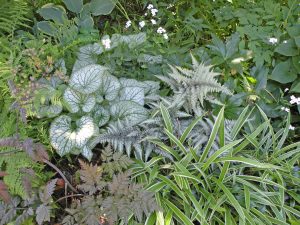
Variegated foliage: Athyrium filix-femina ‘Rotstiel’, Brunnera ‘Jack Frost’, Hesperis matrionalis, Hosta, Anthriscus sylvestris ‘Ravenswing’, Athyrium niponicum ‘Pictum’, Carex siderosticha ‘Variegata’ (lower right hand corner)
Although the garden is dormant, now is a great time to start thinking about changes you want to make in your garden.
Discussions of perennial garden design always focus on differences of form, height, size and type of foliage, color, and time of bloom. More recently, a lot of attention has been paid to extending seasonal interest with deadheads.
So, even after taking all of those characteristics into consideration, is the garden interesting even if nothing is in bloom? I don’t think we give enough weight to the importance of variegated foliage. Therefore, I am going to offer several suggestions, starting with ornamental grasses.

Carex ‘Ice Dance’
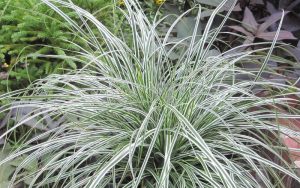
Carex ‘Everest’-wilsonbros.com
The first variegated ornamental grass that often comes to mind is Miscanthus (Maiden Grass). However, it is commonly used so I wish to offer grasses that may not come to mind so quickly. Particularly in shade, I use several different Carex (Sedge) cultivars. For years, ‘Ice Dance’, with its green and white foliage, has been a standby for me. It is extremely versatile, growing well in sun or shade, in dry to moist soil. In dry soil, it holds its ground but does not move; in damp soil, it travels, acting as a groundcover. ‘Everest’ is similar but has a narrower leaf while ‘Ice Cream’ and ‘Frosted Curls’ have extremely narrow leaves. On the other hand, if you want a leaf that is even wider than that of ‘Ice Dance’, try Carex siderosticha ‘Variegata’. It will spread slowly. All of these sedges have relatively unremarkable blooms.
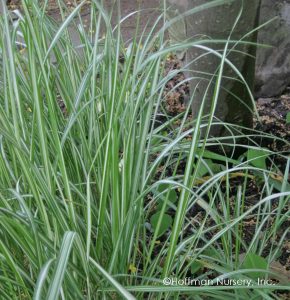
Calamagrostis acutiflora ‘Avalanche’-hoffmannursery.com
Although touted as suitable for partial shade or full sun, I would grow Calamagrostis acutiflora ‘Avalanche’ or ‘Overdam’ in full sun because they tend to lean toward the light when planted in shade. The foliage of ‘Overdam’ has white edges and is three feet tall while that of ‘Avalanche’ has a white stripe down the middle of the leaf and grows three to five feet tall. The variegation is subtle when seen from a distance so almost looks blue-gray. The inflorescences of Calamagrostis bloom in early summer and last throughout the growing seasons.
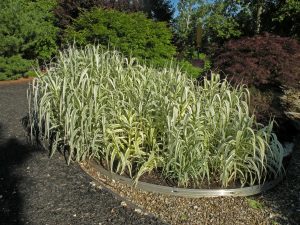
Arundo donax ‘Variegata’
An unusual choice for a sun-loving grass is Arundo donax ‘Peppermint Stick’ (an improvement over ‘Variegata’). You would swear that you are looking at giant, variegated cornstalks because they grow six to twelve feet tall. The height and strong variegation make this grass a standout in the garden. Plant it in the back of the bed and then plant something else with strong variegation in the middle and/or the front of the bed. This is another versatile grass, thriving in wet to dry soils but at its best in moist soil.

Carex muskingumensis ‘Oehme’
If you want green and yellow variegation, Carex muskingumensis ‘Oehme’ could be the answer. Taller at two feet than the sedges mentioned above, it is more upright and more horizontal than other sedges. It is also more aggressive so siting is crucial. I’ve seen it used as a partial border in a perennial garden but the gardener mentioned that he had to keep after it so it wouldn’t take over. I want you to know about it but would give it a space of its own or pair it with another aggressive plant and let them fight it out.
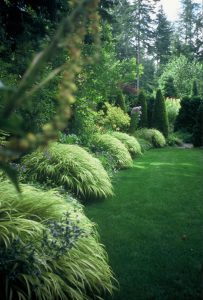
Hakonechloa macra ‘Aureola’ as border
You can’t go wrong with Hakonechloa macra ‘Aureo-Variegata’, The clumps will be wider than those of most Carex and prefer partial shade although will tolerate full sun as long as there is sufficient moisture. Planted on a slope, it resembles a waterfall. Planted intermittently as a border, it is absolutely striking.
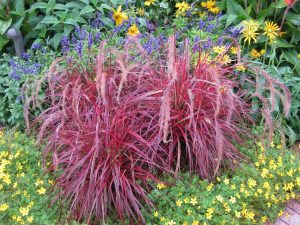
Pennisetum ‘Fireworks’
All of the grasses I have mentioned so far are hardy to at least zone 5 but I want to bring one tropical grass to your attention. Its color is burgundy red with a pink edge. Pennisetum setaceum ‘Fireworks’ is a real eye-catcher and I use it to energize pastel gardens. This is a sun lover that is not a water guzzler. Its purplish inflorescence is also extremely attractive.
Next time, I’ll offer some perennial suggestions.


2 Comments